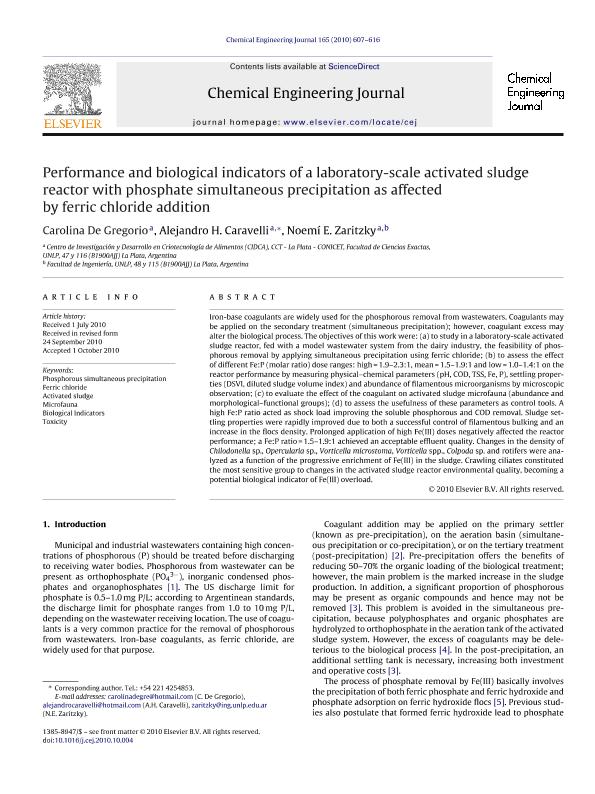Mostrar el registro sencillo del ítem
dc.contributor.author
de Gregorio, Carolina

dc.contributor.author
Caravelli, Alejandro Horacio

dc.contributor.author
Zaritzky, Noemi Elisabet

dc.date.available
2021-05-05T12:00:46Z
dc.date.issued
2010-12
dc.identifier.citation
de Gregorio, Carolina; Caravelli, Alejandro Horacio; Zaritzky, Noemi Elisabet; Performance and biological indicators of a laboratory-scale activated sludge reactor with phosphate simultaneous precipitation as affected by ferric chloride addition; Elsevier Science SA; Chemical Engineering Journal; 165; 2; 12-2010; 607-616
dc.identifier.issn
1385-8947
dc.identifier.uri
http://hdl.handle.net/11336/131342
dc.description.abstract
Iron-base coagulants are widely used for the phosphorous removal from wastewaters. Coagulants may be applied on the secondary treatment (simultaneous precipitation); however, coagulant excess may alter the biological process. The objectives of this work were: (a) to study in a laboratory-scale activated sludge reactor, fed with a model wastewater system from the dairy industry, the feasibility of phosphorous removal by applying simultaneous precipitation using ferric chloride; (b) to assess the effect of different Fe:P (molar ratio) dose ranges: high = 1.9-2.3:1, mean = 1.5-1.9:1 and low = 1.0-1.4:1 on the reactor performance by measuring physical-chemical parameters (pH, COD, TSS, Fe, P), settling properties (DSVI, diluted sludge volume index) and abundance of filamentous microorganisms by microscopic observation; (c) to evaluate the effect of the coagulant on activated sludge microfauna (abundance and morphological-functional groups); (d) to assess the usefulness of these parameters as control tools. A high Fe:P ratio acted as shock load improving the soluble phosphorous and COD removal. Sludge settling properties were rapidly improved due to both a successful control of filamentous bulking and an increase in the flocs density. Prolonged application of high Fe(III) doses negatively affected the reactor performance; a Fe:P ratio = 1.5-1.9:1 achieved an acceptable effluent quality. Changes in the density of Chilodonella sp., Opercularia sp., Vorticella microstoma, Vorticella spp., Colpoda sp. and rotifers were analyzed as a function of the progressive enrichment of Fe(III) in the sludge. Crawling ciliates constituted the most sensitive group to changes in the activated sludge reactor environmental quality, becoming a potential biological indicator of Fe(III) overload.
dc.format
application/pdf
dc.language.iso
eng
dc.publisher
Elsevier Science SA

dc.rights
info:eu-repo/semantics/openAccess
dc.rights.uri
https://creativecommons.org/licenses/by-nc-sa/2.5/ar/
dc.subject
ACTIVATED SLUDGE
dc.subject
BIOLOGICAL INDICATORS
dc.subject
FERRIC CHLORIDE
dc.subject
MICROFAUNA
dc.subject
PHOSPHOROUS SIMULTANEOUS PRECIPITATION
dc.subject
TOXICITY
dc.subject.classification
Biotecnología Medioambiental

dc.subject.classification
Biotecnología del Medio Ambiente

dc.subject.classification
INGENIERÍAS Y TECNOLOGÍAS

dc.title
Performance and biological indicators of a laboratory-scale activated sludge reactor with phosphate simultaneous precipitation as affected by ferric chloride addition
dc.type
info:eu-repo/semantics/article
dc.type
info:ar-repo/semantics/artículo
dc.type
info:eu-repo/semantics/publishedVersion
dc.date.updated
2021-04-23T13:49:00Z
dc.identifier.eissn
1873-3212
dc.journal.volume
165
dc.journal.number
2
dc.journal.pagination
607-616
dc.journal.pais
Países Bajos

dc.journal.ciudad
Amsterdam
dc.description.fil
Fil: de Gregorio, Carolina. Provincia de Buenos Aires. Gobernación. Comisión de Investigaciones Científicas. Centro de Investigación y Desarrollo en Criotecnología de Alimentos. Consejo Nacional de Investigaciones Científicas y Técnicas. Centro Científico Tecnológico Conicet - La Plata. Centro de Investigación y Desarrollo en Criotecnología de Alimentos. Universidad Nacional de La Plata. Facultad de Ciencias Exactas. Centro de Investigación y Desarrollo en Criotecnología de Alimentos; Argentina
dc.description.fil
Fil: Caravelli, Alejandro Horacio. Provincia de Buenos Aires. Gobernación. Comisión de Investigaciones Científicas. Centro de Investigación y Desarrollo en Criotecnología de Alimentos. Consejo Nacional de Investigaciones Científicas y Técnicas. Centro Científico Tecnológico Conicet - La Plata. Centro de Investigación y Desarrollo en Criotecnología de Alimentos. Universidad Nacional de La Plata. Facultad de Ciencias Exactas. Centro de Investigación y Desarrollo en Criotecnología de Alimentos; Argentina
dc.description.fil
Fil: Zaritzky, Noemi Elisabet. Provincia de Buenos Aires. Gobernación. Comisión de Investigaciones Científicas. Centro de Investigación y Desarrollo en Criotecnología de Alimentos. Consejo Nacional de Investigaciones Científicas y Técnicas. Centro Científico Tecnológico Conicet - La Plata. Centro de Investigación y Desarrollo en Criotecnología de Alimentos. Universidad Nacional de La Plata. Facultad de Ciencias Exactas. Centro de Investigación y Desarrollo en Criotecnología de Alimentos; Argentina. Universidad Nacional de La Plata. Facultad de Ingeniería; Argentina
dc.journal.title
Chemical Engineering Journal

dc.relation.alternativeid
info:eu-repo/semantics/altIdentifier/doi/http://dx.doi.org/10.1016/j.cej.2010.10.004
dc.relation.alternativeid
info:eu-repo/semantics/altIdentifier/url/https://bit.ly/3gQ8ybV
Archivos asociados
